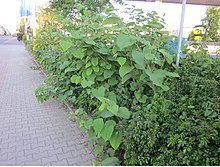Reynoutria × bohemica
This article was based on formal or substantive deficiencies in the quality assurance biology in the section "plants" entered for improvement. This is done in order to bring the quality of the biology articles to an acceptable level. Please help improve this article! Articles that are not significantly improved can be deleted if necessary.
Read the more detailed information in the minimum requirements for biology articles .
Reason: Document-free + completely new format for a plant article
The hybrid knotweed ( Fallopia × bohemica (Chrtek & Chrtková) JPBailey), also known as Bohemian knotweed hybrid knotweed or hybrid knotweed , is a hybrid of the genus winged knotweed ( Fallopia ) within the knotweed family (Polygonaceae). It is a natural, fertile hybrid of Japanese knotweed ( Fallopia japonica ) and Sakhalin knotweed ( Fallopia sachalinensis ).
The hybrid knotweed is an invasive plant in many parts of the world . Due to its spreading potential and the damage in the areas of biodiversity , health and economy, it was added to the black list of invasive neophytes in Switzerland and subject to the release ordinance.
description
The Bastard Knotweed is a deciduous, perennial herbaceous plant . It forms underground rhizomes as persistence organs. They usually form dense stands that are hardly overgrown by other plants. The characteristics of its plant parts are intermediate to those of its parents.
| feature | Japanese knotweed | Bastard knotweed | Sakhalin knotweed |
|---|---|---|---|
| Stem height | approx. 2.5 m | approx. 3 m | approx. 4 m |
| Stain on the stem | dense, clearly demarcated, red-brown | washed out, red-brown | no |
| Sheet size | 19 cm × 12 cm | 26 cm × 18 cm | 41 cm × 25 cm |
| Leaf shape | broad, straight leaf base | Intermediate expression | long, heart-shaped leaf base |
| Leaf structure | leathery | papery | soft |
| Hairiness on the underside of the leaf | no | with short hair, barely visible | visible |
The plant shows a more aggressive spreading behavior and a better ability to regenerate than its parent species ( heterosis effect ). It has less site conditions, so it is also competitive in shaded and drier areas.
Web links
Individual evidence
- ^ Federal Office for the Environment FOEN: Invasive Alien Species . ( admin.ch [accessed on August 6, 2019]).
- ↑ S. Buholzer, M. Nobis, N. Schoenenberger, S. Rometsch: List of the alien invasive plants of Switzerland . Ed .: Infoflora. ( infoflora.ch [accessed on August 6, 2019]).

